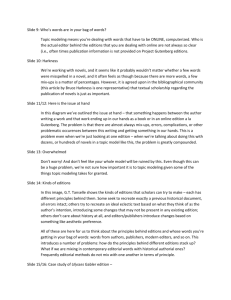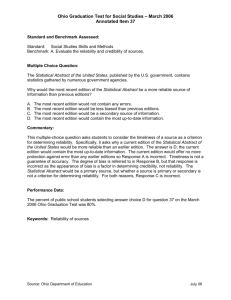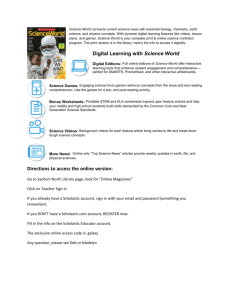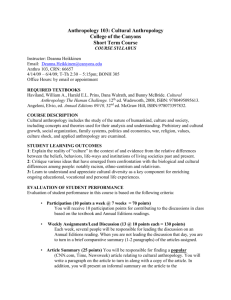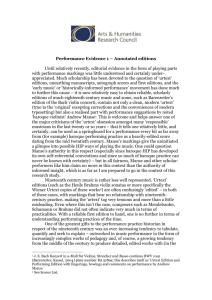Locating works in Collected Editions
advertisement
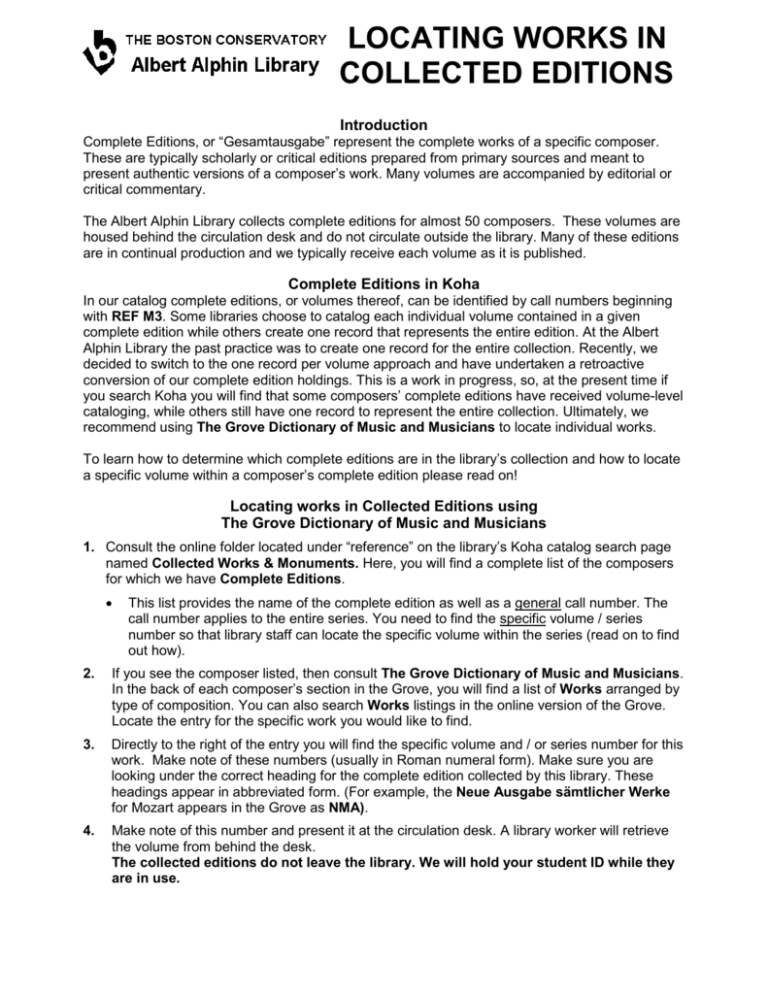
LOCATING WORKS IN COLLECTED EDITIONS Introduction Complete Editions, or “Gesamtausgabe” represent the complete works of a specific composer. These are typically scholarly or critical editions prepared from primary sources and meant to present authentic versions of a composer’s work. Many volumes are accompanied by editorial or critical commentary. The Albert Alphin Library collects complete editions for almost 50 composers. These volumes are housed behind the circulation desk and do not circulate outside the library. Many of these editions are in continual production and we typically receive each volume as it is published. Complete Editions in Koha In our catalog complete editions, or volumes thereof, can be identified by call numbers beginning with REF M3. Some libraries choose to catalog each individual volume contained in a given complete edition while others create one record that represents the entire edition. At the Albert Alphin Library the past practice was to create one record for the entire collection. Recently, we decided to switch to the one record per volume approach and have undertaken a retroactive conversion of our complete edition holdings. This is a work in progress, so, at the present time if you search Koha you will find that some composers’ complete editions have received volume-level cataloging, while others still have one record to represent the entire collection. Ultimately, we recommend using The Grove Dictionary of Music and Musicians to locate individual works. To learn how to determine which complete editions are in the library’s collection and how to locate a specific volume within a composer’s complete edition please read on! Locating works in Collected Editions using The Grove Dictionary of Music and Musicians 1. Consult the online folder located under “reference” on the library’s Koha catalog search page named Collected Works & Monuments. Here, you will find a complete list of the composers for which we have Complete Editions. This list provides the name of the complete edition as well as a general call number. The call number applies to the entire series. You need to find the specific volume / series number so that library staff can locate the specific volume within the series (read on to find out how). 2. If you see the composer listed, then consult The Grove Dictionary of Music and Musicians. In the back of each composer’s section in the Grove, you will find a list of Works arranged by type of composition. You can also search Works listings in the online version of the Grove. Locate the entry for the specific work you would like to find. 3. Directly to the right of the entry you will find the specific volume and / or series number for this work. Make note of these numbers (usually in Roman numeral form). Make sure you are looking under the correct heading for the complete edition collected by this library. These headings appear in abbreviated form. (For example, the Neue Ausgabe sämtlicher Werke for Mozart appears in the Grove as NMA). 4. Make note of this number and present it at the circulation desk. A library worker will retrieve the volume from behind the desk. The collected editions do not leave the library. We will hold your student ID while they are in use. What if the library does not have the particular volume I need? The volumes listed in the Grove are often pre-cataloged and may be listed before a volume has been published. Libraries subscribe to the publisher to receive each new volume as it is issued. Even if the volume appears in the Grove, the work you seek may be in production or awaiting publication. It is also possible that a volume has been published and is missing from the library’s collection. Many collected editions are still in production. Sometimes, the publisher neglects to send a volume when it is issued. We are working on filling these gaps. In the meantime, you could try checking another library’s holdings. Complete Editions Online There is a growing trend of publishing collected editions on the web. These include the following: J.S. Bach, http://einam.com/bach/ W.A. Mozart, http://dme.mozarteum.at/DME/nma/ The Munich Digitization Center has digitized the collected works of Beethoven, Schubert, and Schumann, which can be found here: http://www.digitale-sammlungen.de/ (Be sure to click the link that says “English.”). The IMSLP Petrucci Music Library has also digitized the complete works of several different composers. These can be found on their category page called “Editions”: http://imslp.org/wiki/Category:Editions Incomplete Editions Online There are many libraries and archives that have undertaken projects to digitize their scores. They might not be a complete representation of a composer’s output, but they can be useful nonetheless. Some examples are the following: Beethoven, http://www.beethoven-hausbonn.de/sixcms/detail.php?template=startseite_digitales_archiv_en Chopin, http://chopin.lib.uchicago.edu/ Gilbert and Sullivan, http://diamond.boisestate.edu/gas/html/opera_index.html Liszt, on the Munich Digitization Center’s website: http://www.digitale-sammlungen.de/ Lully, http://digital.library.unt.edu/explore/collections/JBLC/ Schubert, http://www.schubert-online.at/ (click “English Version”) The IMSLP Petrucci Music Library, http://imslp.org/wiki/, is also an excellent resource with an abundance of digitized scores. Be aware that because of copyright restrictions, most digitized scores online are of older works. Scores of newer works are occasionally available when the composer gives his or her consent.
